Cinderella a Political Idealist in Muny Production
FTC Statement: Reviewers are frequently provided by the publisher/production company with a copy of the material being reviewed.The opinions published are solely those of the respective reviewers and may not reflect the opinions of CriticalBlast.com or its management.
As an Amazon Associate, we earn from qualifying purchases. (This is a legal requirement, as apparently some sites advertise for Amazon for free. Yes, that's sarcasm.)

Many years ago, I attended a viewing of CHESS when it came to St. Louis. I had enjoyed the soundtrack so much, I could not wait to see it performed. That was when I learned that scripts could be changed from the originals depending on the situation. In the post-Glasnost environment of the time, CHESS had been altered so that it was no longer the same story I had learned from the album.
That's not quite the case with RODGERS & HAMMERSTEIN'S CINDERELLA, although the musical is surprisingly obscure enough to surprise and/or disappoint viewers who expect the more commonly known Disney version of the magical romance. Indeed, I overheard conversations in the parking lot afterward comparing the show to prior Disney-based musicals like BEAUTY AND THE BEAST and THE LITTLE MERMAID, stating how they had remained closer to the source, and there were a handful of young girls who had arrived to the show wearing their best pale blue gowns and tiaras.
For those unfamiliar with this version of the tale, a lot remains familiar. Ella lives with her social-climbing stepmother and two stepsisters. The prince is required to find a wife, a ball is held, and Cinderella crashes the party with help from her fairy godmother. That takes you through the first act of this musical, during which we also meet a political firebrand who speaks out on behalf of the disposssessed who are losing their property to the government, and a scheming politico who assists the naive prince by manipulating him into signing laws he doesn't read. That's all in the Rodgers & Hammerstein version, which was written for television in the late 1950s. Pepper that with a little current year, and you may understand why audience members might wonder what it was they were watching.
Despite the story not quite striking a chord with the audience, the performances from the players were unparalleled. Mikaela Bennett plays Ella with full-throated energy, delivering "In My Own Little Corner" with a sound on par with Laura Osnes, who was nominated for a Tony for the same role. Stephanie Gibson plays sympathetic stepsister Gabrielle, who is her mother's intended for the Prince, but who harbors a flame for the political protestor Jean-Michel (Chad Burris). The pair are comic relief, with Gibson seemingly drawing upon her inner Laurie Metcalf by way of Carol Burnett. And as long as I'm noting the standout performances, I would be remiss if I did not mention Victor Ryan Robertson, who plays Lord Pinkleton, the royal crier who announces the ball with a rousing operatic tenor.
Alison Fraser plays Madame (aka the stepmother), dropping lines of sarcasm and ridicule with discomfort. However, her character doesn't truly shine until she discovers Gabrielle's forbidden love with Jean-Michel. Stepsister Charlotte (Jennifer Cody) is a delight in her overstated self-assuredness, and pleases with her rendition of "The Stepsister's Lament."
Jason Gotay embodies the bored and out-of-touch Topher, the orphaned prince who is controlled by his royal advisor, Sebastian, played by John Scherer. Their relationship evolves over the course of the show as we see Topher become more aware of what is going on in his kingdom, thanks to information received from Cinderella. (Indeed, it is to bring this knowledge to the prince that Cinderella attends the ball in the first place, as a favor to her friend Jean-Michel; falling in love is a secondary-but-welcomed by-product of their meeting.) Gotay captures the audience with his solo of "Ten Minutes Ago" and his duet with Bennett, "Do I Love You Because You're Beautiful." Scherer has no solo vocals, but is indispensible in carrying the songs in which he is part of the ensemble, making his presence unique without stealing the spotlight. (Okay, his aside comment about "The Muny raccoons" might have been a bit over-the-top, but it helped break the ice with the audience.)
This brings us to the role of the Fairy Godmother, aka Crazy Marie. It's telegraphed fairly early on that the town's harmless kook, Marie, is going to be important, particularly after both Topher and Ella show her charitable kindness. Think of her as the visiting fairy who curses The Beast in that other fairy tale for his completely opposite behavior. The costuming here for Crazy Marie falls away nicely when her true identity is ultimately revealed, allowing actress Ashley Brown to finally capture some spotlight. Not only is Marie important for getting Cinderella to the ball, she also has to help her get to the following banquet (with similar midnight deadlines), and tossign a bit of magic into Ella's conversation with the Prince regarding how to reconcile with the angry people -- which is done by introducing the concept of free and fair elections for Prime Minister.
Detracting from all these excellent performances is the wardrobe. The ensemble and chorus are all nicely done, but they're designed to fade into the background so the major characters can stand out. Topher's princely garb is sharp and sufficient, and Ella's workdress is appropriately frumpy. But beyond that, mistakes are made. Ella's ball gown is less than glamorous, looking more like a diaphonous tie-dye gown than something that makes one see a princess. Her later gown for the banquet is most charitably described as a Walmart quality golden prom dress. And then there is Madame and her two daughters. Granted, their style is intentionally over-the-top to communicate their eagerness to be on the cutting edge of culture by making exquisitely garish fashion choices. However, while Charlotte and Gabrielle's outfits are suitably unattractive and gawky, Madame's eye-gougingly garish outfit, powdered makeup, and emerald coiffure have the audience wondering if this is supposed to be Cinderella's stepmother or Batman's arch-nemesis.
If you know what you're getting into, you're likely going to enjoy this adaptation. If you are not familiar with the Rodgers and Hammerstein version, you can still appreciate the performance and score, as long as you table your Disney expectations, and communicate to your attending children that there isn't a bibbity, bobbity, or boo to be had here.


